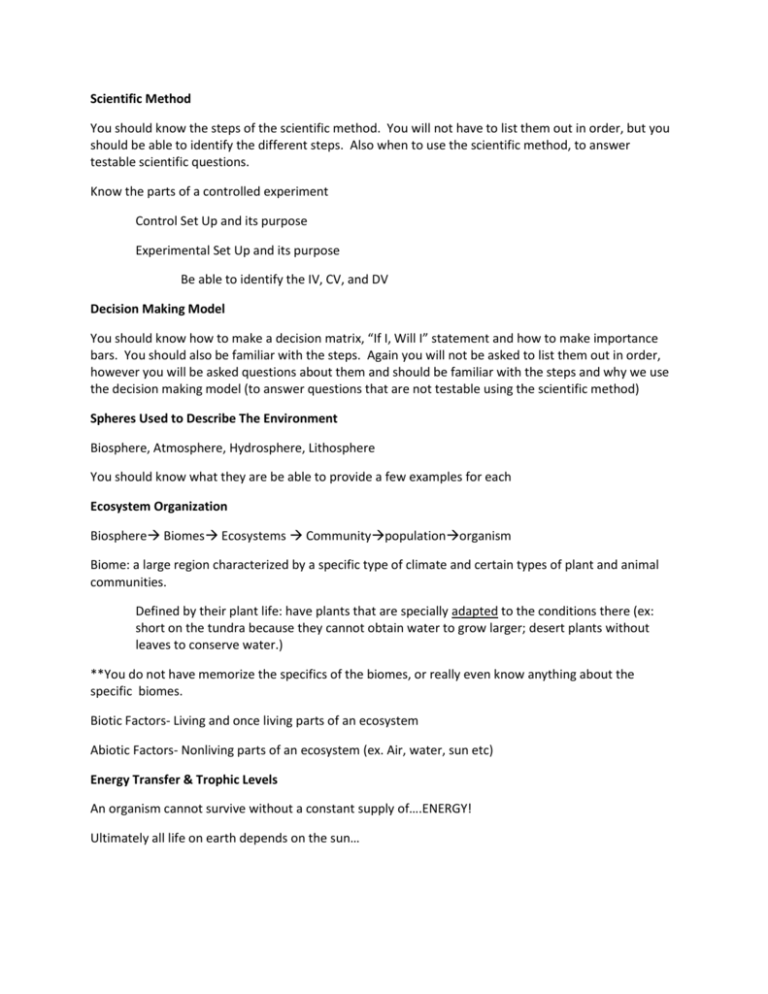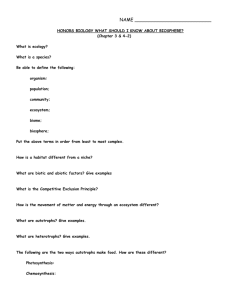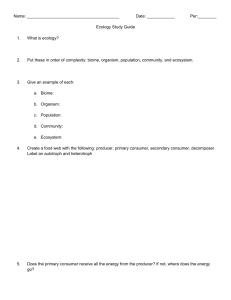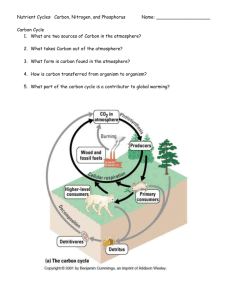Scientific Method You should know the steps of the scientific method
advertisement

Scientific Method You should know the steps of the scientific method. You will not have to list them out in order, but you should be able to identify the different steps. Also when to use the scientific method, to answer testable scientific questions. Know the parts of a controlled experiment Control Set Up and its purpose Experimental Set Up and its purpose Be able to identify the IV, CV, and DV Decision Making Model You should know how to make a decision matrix, “If I, Will I” statement and how to make importance bars. You should also be familiar with the steps. Again you will not be asked to list them out in order, however you will be asked questions about them and should be familiar with the steps and why we use the decision making model (to answer questions that are not testable using the scientific method) Spheres Used to Describe The Environment Biosphere, Atmosphere, Hydrosphere, Lithosphere You should know what they are be able to provide a few examples for each Ecosystem Organization Biosphere Biomes Ecosystems Communitypopulationorganism Biome: a large region characterized by a specific type of climate and certain types of plant and animal communities. Defined by their plant life: have plants that are specially adapted to the conditions there (ex: short on the tundra because they cannot obtain water to grow larger; desert plants without leaves to conserve water.) **You do not have memorize the specifics of the biomes, or really even know anything about the specific biomes. Biotic Factors- Living and once living parts of an ecosystem Abiotic Factors- Nonliving parts of an ecosystem (ex. Air, water, sun etc) Energy Transfer & Trophic Levels An organism cannot survive without a constant supply of….ENERGY! Ultimately all life on earth depends on the sun… Energy from the sun enters an ecosystem when a plant uses sunlight to make sugar molecules during photosynthesis. As organisms consume and use energy from carbohydrates, the energy travels from one organism to another. Organisms use this energy to move, grow and reproduce. Producer: an organism that makes its own food; also called autotrophs; get their energy directly from the sun. Consumer: an organism that gets their energy from eating other organisms; also called heterotrophs; get their energy indirectly from the sun. Eat only producers=herbivores Eat only consumers=carnivores Eat producers and consumers=omnivores Consumers that get food by breaking down dead organisms= decomposers Energy Transfer: Each time an organism eats another organism, an energy transfer takes place. Trophic level: each step through which energy is transferred in a food chain. Each time energy is transferred from one organism to another, some of the energy is lost as heat and less energy is available to organisms at the next trophic level. Some energy is lost in cellular respiration. Organisms use energy to carry out functions of life. 90% of energy at each tropic level is used. Only the remaining 10% can be part of the organism’s body and stored in its molecules. This stored 10% is all that is available for the next trophic level when one organism consumes another.Decreased amount of energy at each trophic level affects ecosystem organization. Since so much energy is lost, there are fewer organisms at the higher levels. This also limits the number of levels in an ecosystem. You should also know how to read a food web, and know what happens if one part of the food chain is removed. You should know the 9 types of energy and be able to identify examples of each energy type in energy transformations. Carbon Cycle Process by which carbon is recycled between the atmosphere, land, water and organisms. Photosynthesis and Respiration: Producers absorb atmospheric carbon dioxide in the atmosphere into carbohydrates during photosynthesis. When consumers eat producers, the consumers obtain carbon from the carbohydrates. As the consumers break down the food, some of the carbon is released back into the atmosphere as carbon dioxide. This could be considered the biotic part. You should know the chemical equations for photosynthesis and respiration. Other parts of the Carbon Cycle: Carbon may be converted into carbonates (parts of bones and shells). These carbonate deposits produce limestone rock deposits over millions of years. Limestone is known as one of the largest carbon sinks on Earth. Some carbohydrates in organisms are converted into fats, oils and other molecules that store energy. The carbon in these molecules may be released after the organisms die. These molecules may form deposits of coal, oil or natural gas underground…fossil fuels are made up of carbon compounds from the bodies of organisms that died millions of years ago. This could be considered the biotic part Human Effect on this Cycle: Atmospheric CO2 is increasing due to increased use of fossil fuels. Nitrogen Cycle Makes up 78% of the atmosphere, but most organisms cannot use atmospheric nitrogen. This change from atmospheric nitrogen to nitrogen compounds that can be used can only be done by nitrogen-fixing bacteria. Bacteria live in nodules on the roots of legumes (beans, peas, clover), they are also free living in the soil. They use sugars from the plants to produce nitrates. The excess nitrates are released into the soil. Plants get nitrogen from the soil, animals get nitrogen from plants. Nitrogen returns to the soil through animal waste as well as death and decay. Nitrogen is needed for protein structure and DNA. In order to get the nitrogen back to the atmosphere, bacteria is needed in this step as well. Phosphorus Cycle When rocks erode, small amounts of phosphorus enter soil and water. Plants absorb phosphates through their roots. Plants pass that phosphate on to animals when animals eat plants. They both pass back to soil through decay, eventually this can be made into rocks. Phosphorus is needed to form bones and teeth in mammals; is a component of cells, specifically DNA Human Effect on Nitrogen & Phosphorus Cycle Fertilizer use adds excess phosphorus and nitrogen to the environment, which enters waterways through runoff and cause algae blooms.(eutrophication) Acid rain adds extra nitrogen to the ecosystem in the form of nitric acid. **This is not on it, but you will see this concept again later** Succession This is the process ecosystems go through after some type of disturbance. The end result of succession is return to a stable form Primary Succesion: Occurs on new land formations, i.e. volcanoes Secondary Succession: Occurs on existing land forms, i.e. forest fire










